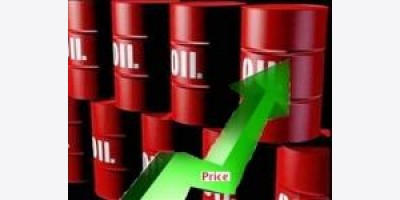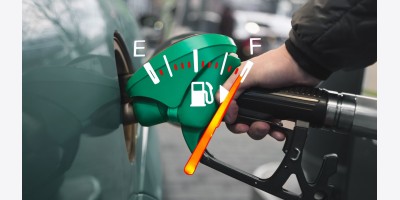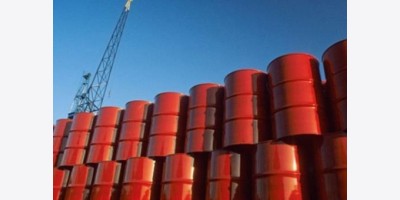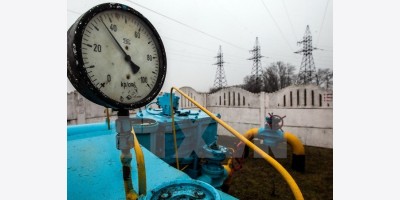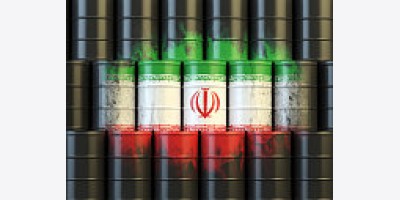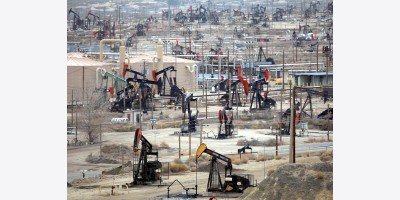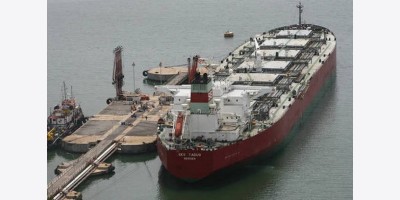Is oil on the rebound?
In the longer-run, we expect the new-normal crude oil price to average below the previous years of US$110 per barrel - at around US$80 per barrel,’’ said Manokaran Mottain(inset right bottom), chief economist, Alliance Bank.
In the longer-run, we expect the new-normal crude oil price to average below the previous years of US$110 per barrel - at around US$80 per barrel,’’ said Manokaran Mottain(inset right bottom), chief economist, Alliance Bank.
WHEN the price of oil, which has been depressed for some time, spiked up momentarily to US$60 per barrel, many people wondered what the medium term outlook would be. Expectations ranged from low to slightly bullish.
“We are looking at crude oil price averaging US$50-55 per barrel this year (2015 year-to-date: US$52 per barrel) and US$65-US$70 per barrel in the next two years.
“We expect the excess supply situation to ease gradually amid modest global economic growth, so we are not looking at a sharp rebound back to US$100 per barrel anytime soon,’’ said Suhaimi Ilias, chief economist, Maybank Investment Bank.
“Global oil prices should hover between US$60 and US$80 per barrel over the next two years, based on readings of oil demand and supply dynamics, the shale revolution, Canadian oil sands and sustained Opec supplies.
“These stack up against the lower energy intensity of global growth and a slower growth trajectory compared to the pre-global financial crisis period. The wild cards are geopolitics and fears that a cold war may be coming,’’ said Julia Goh, director/regional economist, CIMB Investment Bank.
“As for gasoline prices paid at the pump, assuming that global oil prices stay below US$80 per barrel, my best guess is that RON 95 prices could be capped at below RM2.30 per litre,’’ said Goh.
“While Brent crude oil price has increased in February to around US$58 per barrel, up from the January average of US$50 per barrel, we think that volatility in oil price should likely continue and the uptrend is not sustainable.
“Currently, the short-term trading of crude oil is influenced by news flow of oil and gas sector developments in the US and also in the Opec area.
“However, the state of the global oil and gas market has not changed much since the fall in crude oil prices.
“Crude oil inventories are still likely to remain high this year while it will take a longer time to see a decrease in global crude oil supply,’’ said Manokaran Mottain, chief economist, Alliance Bank.
The fundamentals of the global oil market have changed with the advancement of new shale oil extraction technology.
“For now, supply-side factors will be the key driver to crude oil prices – primarily, capital expenditure allocation in global oil and gas companies and actions from the Opec.
“Uptake in global demand would also be a welcome boost to stabilise crude oil prices.
‘’In the longer-run, we expect the new-normal crude oil price to average below the previous years of US$110 per barrel - at around US$80 per barrel,’’ added Manokaran.
“We have revised our crude oil price assumptions to US$72.50 per barrel (from US$79.75) for 2015 and US$80 per barrel (from US$95 per barrel) for 2016 onwards.
“We expect stronger crude oil prices in the second half of the year, as the oversupply of oil is expected to improve by then,’’ said Alexander Chia, head of Malaysia research, RHB Research Institute.
Opec expects a surplus of 1.13 million barrels per day in 2015, with 1.83mil barrels per day of surplus supply in the first half of the year. Therefore, for the second half, it is expected at 430,000 barrels per day.
“I do not expect oil prices to remain at the current level for more than six to nine months.
“They are likely to rebound although they may not reach the levels during their heydays a few years back.
“If history is any guide, oil prices have never remained below two standard deviations (SD) from their mean for more than six to nine months (based on data since the early 1990s).
“They have reverted to at least one SD below their mean within two to three quarters.
“Currently, they are below two SDs of their mean. Fundamentally speaking, although supply (especially from the US) seems to suggest that prices will remain depressed for quite a while, expectations of a slowdown in production will likely emerge by middle of the year, sparking concerns about the possible pick-up in prices again.
“Such expectations will cause oil prices to rebound to possibly around US$65-US$75 per barrel, in my view,’’ said Nor Zahidi Alias, associate director of economic research and chief economist at Malaysian Rating Corp.
“On the demand side, I foresee the soft landing of China’s economy as part of the reasons why people will become less pessimistic about the future for oil demand.
“Cruising with a real growth rate of around 7%-7.5% (for China), this will not likely cause a further significant drop in global oil demand,’’ added Nor Zahidi.
It looks like it is going to be quite a long period of adjustment to lower oil prices.
That should give enough lead time for businesses that use oil as a major component in their raw materials to make arrangements for the proper pricing of their products and services. There will also be new economic realities to be dealt with in the next two to three years as our economy looks for more diversified sources of income.
Columnist Yap Leng Kuen looks forward to cheaper fuel prices and hence, more disposable income in the next few years.
Oil prices can ‘bounce back’ to $80 per barrel
Davy Stockbrokers is forecasting a recovery and tightening in global oil prices in the second half of this year, adding that numbers can rise from the current $59 to $60 per barrel level to a long-term price of $80 per barrel.
“While the edge may have come off demand growth, the primary driver of weaker oil prices has been the relentless increase in US light tight oil or shale-based oil that requires controversial methods, such as ‘fracking’ to find] production and, to a lesser extent, sustained output from OPEC,” said Job Langbroek, Davy’s senior exploration and mining analyst in a new detailed report on the price of oil.
“We believe that US light tight oil will play the biggest role in determining oil pricing in the near future and possibly for the rest of the decade. While producing the same end product using the same industry technology, as a business model it is very different from conventional exploration and production.”
In its report, Davy also suggests that low oil prices will eventually lead to deferred drilling and a fall in production.
“This should begin to be visible in the second or third quarter and lead to tighter second-half crude oil prices. In the longer term, we think the progress in cost reduction, shown by the US light tight oil business and the depth of the service industry, will enable it to restart drilling when pricing recovers,” said Mr Langbroek.
“Our calculations suggest that to achieve average industry returns, a trading range of $70 to $90 per barrel is required. With this as a template, our long-term forecast sits in the middle, at $80 per barrel.
“We believe oil markets will recover later this year, as evidence mounts that not enough wells are being drilled to offset the rapid production decline characteristic of light tight oil production.
“However, light tight oil also has the capacity to rapidly react to improving price trends.”
Davy’s $80 per barrel price estimate is a long-term target, however. For this year, it is predicting an average international oil price of $55 per barrel, with that price rising to around $70 per barrel next year, “as the effect of sub-$50 local pricing effects is felt through the US light tight oil industry”.
“We assume a longer-term oil price of $80 per barrel,” Davy’s added. The light tight oil sector, the report states, is the largest player in the recent oil price decline drama.
“This business was a catalyst for the price fall and, as long as viable drill targets exist, will form an effective ceiling for prices in the future” said Mr Langbroek. “As the US tight oil play matures and reaches a plateau, the tension between technology, costs and geology may well throw up different scenarios. For now however, it remains the key to how the oil price will evolve in the next few years.”
Davy says its price assumptions will help Irish exploration firms.
According to Mr Langbroek: “We think Tullow Oil has the most leverage to a recovery in oil prices in the second half of the year. Its west African operations will be extremely profitable at an $80 per barrel realisation and, while not as stellar, the east African projects in Uganda and Kenya are fundamentally sound and undervalued at this long-term price assumption.
“At $80 per barrel, our valuation for Tullow is 561p per share, compared to a share price of 398p at present.”
© Irish Examiner Ltd. All rights reserved
US Will Never Gain Oil Market Crown Says IEA Head
No matter how much oil the United States produces over the next few years, it will never become the next Saudi Arabia in the global oil market, according to Fatih Birol, the new executive director of the International Energy Agency (IEA).
What's especially interesting about this forecast is that it directly contradicts what Birol said only three months ago, and he gave no explanation for his change of mind.
On Feb. 26, Birol told The Telegraph’s Middle East Congress in London that OPEC, particularly the Persian Gulf members, will prevail over all other producers for the foreseeable future, even though the revolution in extracting shale oil has been “excellent news” for American producers.
“The United States will never be a major oil exporter. Their import needs are getting less but the US is not becoming Saudi Arabia,” Birol told the conference. “Their production growth is good to diversify the market but it will not solve the world’s oil problems.”
Certainly, Birol acknowledged, 2014 crude production by countries that are not among OPEC’s 12 members was greater than it had been in three decades, helping create an oversupply of oil that caused prices to erode and robbed OPEC producers of some of their market share.
But at least for the next 10 years, the cartel’s two top producers, Saudi Arabia and Iraq, will be the countries best equipped to meet the world’s demand for energy, especially if non-OPEC producers such as Brazil, Canada and the United States see production falter, Birol said.
Birol’s comments don’t jibe with what he said on Nov. 12, 2014, when he was still the IEA’s chief economist, when introducing the agency’s annual World Energy Outlook. He was appointed to the agency’s top position two weeks ago.
In that report, the IEA said US oil production is likely to exceed Saudi Arabia’s in the next 10 years, making the country nearly self-sufficient in energy and poising it to become a net exporter of oil.
“Around 2017, the U.S. will be the largest oil producer of the world, overtaking Saudi Arabia,” Birol said at a news conference in London the day the report was released. “This is of course a major development and definitely will have significant implications.”
Specifically, the IEA report said, Americans will be pumping 500,000 barrels more than Saudi Arabia in 2020 and 100,000 more than the Saudis in 2025. Riyadh will not reclaim its position as the biggest producer until 2030, when it is expected to extract 1.2 million more barrels per day than US producers.
Whether Birol’s forecast is correct now or was correct in November, he was not alone among noted economists and institutions in expecting a major surge in US oil production. The American financial services company Citigroup Inc. issued a report on March 20, 2014, predicting that the United States will overcome Saudi Arabia and Russia as the world’s largest oil producer by 2020.
And more recently, on Jan. 3, former U.S. Treasury Secretary Lawrence Summers said the growth of US oil production could perhaps displace Saudi Arabia as the world’s largest net exporter. “The United States has the chance to be to the energy economy of the next decade what Saudi Arabia has been for the last two to three decades,” he told the American Economics Association conference in Boston.
No one but Summers and the people at Citigroup know whether they’ve changed their minds since they spoke so glowingly about US oil production. And as for Birol, only he knows why he’s changed his mind. But for people whose livelihoods depend on understanding the arc of the oil market, such contradictions are confusing at best.
By Andy Tully of Oilprice.com
Is Oil Returning To $100 Or Dropping To $10?
If you have been following the price of oil over the last few months, the chances are you’re a little confused. On the one hand you have the likes of A. Gary Shilling who, in this Bloomberg article, loudly trumpets the prospect of oil at $10/Barrel, and on the other there is T. Boone Pickens, who, at the end of last year was predicting a return to $100 within 12-18 months. Pickens prediction has moderated somewhat as WTI and Brent crude have continued to fall, but in January he was still saying that oil would return to $70 or $80/barrel in the near future. So, who is correct?
The answer is neither one. As with most things in life it is unlikely that the truth lies at either extreme. Pickens, and Shilling and other commentators suggesting that oil will fall to levels not seen since 1998, purport to have sound reasons for saying what they do, but the real reasons for such comments are most likely the two oldest human motivations in the book, greed and hubris. “Talking your book” is nothing new in financial markets and, while Pickens has an insider’s knowledge of the oil business, he also has a massive stake in driving oil higher however he can. Shilling is in the business of garnering eyeballs and clicks, hence the competition for the most outrageous prediction among the bears.
I know it isn’t sexy and it probably breaks some unwritten rule of internet hackery to say it, but the most likely scenario is that WTI futures will bounce around current levels for a while before gradually recovering to the $60-$70/Barrel level. It could even reach Pickens’ revised $70 or $80 level before too long, but we are unlikely to see $100 in the near future without some major external influences.
Now that the dust has settled somewhat, the reasons for the big drop are becoming clearer, and it is clear that supply was not the only factor. It was obvious for a while that as fracking unlocked oil deposits in shale and sand that had previously been thought unreachable, supply, particularly in the U.S. would grow considerably. That wasn’t seen as too much of a problem by the market, though, until questions about slowing global economic growth and a rapidly appreciating Dollar were added to the mix in the middle of last year. Once that happened and OPEC made it clear that they would not immediately cut supply and hand power to the upstart U.S. shale producers, the collapse began.
The drop halted at a logical level. In 2008 and 2009 when a complete global economic collapse looked on the cards oil was trading in the mid $40s and that is where support was eventually found. According to EIA data, global oil production in 2008 was an average 74.016 million barrels per day and in the first 10 months of 2014 averaged 77.427 million barrels, an increase of around 5%. Consumption in 2008 was 86.045 million barrels per day and in 2014 was 92.13 million, an increase of 1.2%.
Put simply, supply has increased faster than demand, so a rapid return to oil over $100/Barrel looks extremely unlikely. That said though, in order to believe that the price will fall much further you have to believe that the economic outlook today is worse than it was at the beginning of the deepest recession since 1929. That too seems like a bit of a stretch.
The only logical conclusion then is that in the near term oil will trade in an approximate range of $50-$70. Incidentally, the bottom end of that range represents the inflation adjusted 100 year average price, according to one Morgan Stanley analyst quoted in another Bloomberg article. We shouldn’t, therefore, be shocked that oil is here any more than we should be shocked that publicity hungry columnists and heavily invested oilmen are predicting further wild swings.
By Martin Tillier for Oilprice.com
Here’s What Will Send Oil Prices Back Up Again
By Martin Tillier
Oil’s rapid decline since August of last year has been dramatic. To listen to some commentators you would also think it is unprecedented and irreversible. Those claiming that oil will continue to fall from here and remain low for evermore, however, are flying in the face of both history and common sense. The question we should be asking ourselves is not if oil prices will recover, but when they will.
https://oilprice.com/images/tinymce/Evan1/ada1794.png
From June of 2014 until now, the price of a barrel of West Texas Intermediate (WTI) crude oil has fallen approximately 57 percent. As the above chart shows, there have been drops of a similar percentage five times in the last 30 years. The rate of recovery has been different each time, but recovery has come. In addition, since 1999 the chart shows a consistent pattern of higher lows. In other words, oil is a volatile market, but prices are in a long term upward trend.
Charts can only tell us so much, however. Even a long term trend can be broken if fundamental conditions change, and that, say those predicting that oil will never recover, is what has happened. There is no doubt that supply has increased. Hydraulic fracturing, or “fracking” technology has unlocked reserves of oil and natural gas previously thought of as unrecoverable. Supply alone, however, doesn’t determine price. We must also consider demand, and that has been increasing too.
https://oilprice.com/images/tinymce/Evan1/ada1795.png
According to this chart, from the U.S. Energy Information Agency (EIA), demand has been increasing along with supply since 2010. Admittedly there has been a production surplus since the beginning of 2014 but that is nothing new and is forecast to be back in balance by the end of this year. The increased production, then, is in response to increasing demand; hardly a recipe for a protracted period of low prices. The supply situation makes it unlikely that the recovery will be rapid, but a gradual move up over the next few years is the only logical conclusion.
The low price brigade cites another factor in making their predictions, the rise of alternative energy sources. There is no doubt that there have been significant advances in that area, particularly in wind and solar power, but, according to the EIA, renewables currently account for 11 percent of the world’s energy consumption. That number will undoubtedly grow in the coming years, but, whether we like it or not, oil consumption still looks set to grow over the next few years. Fracking can fill some of that demand, but the simple fact remains that oil is still used extensively, and we are using more of it every year. The price simply cannot stay low for an extended period, but while it does it will delay research and infrastructure spending on renewables, slowing the pace of their adoption.
Any increase in price would be hastened by a decision from OPEC and Saudi Arabia in particular, to reduce production. Right now they say that that is not on the cards, and why would they cut back? Their attitude seems to be that the oversupply was not their doing, and as their oil is cheap to produce, they can sit back and watch those who did cause the problem, most notably the upstart American companies, suffer. OPEC has always played the long game and will undoubtedly do so again, but once the lesson has been taught the pressure to restrict supply somewhat will mount. Again it may take time, but it will probably come.
History tells us that the price of oil will bounce back, but so does basic logic. Oil is a finite resource that we are using at an increasing rate, and as long as that situation remains, the laws of supply and demand mean that the price must recover. That is a good thing. As long as oil remains cheap there is little incentive to invest in the alternatives that we will inevitably need someday, nor to reduce our consumption of what is essentially a dirty fuel source. So, enjoy low fuel prices while you can, but don’t expect them to last forever.
By Martin Tiller of Oilprice.com
Opec supply hits lowest since June on Iraq
LONDON, 20 hours, 19 minutes ago
Opec's oil supply fell in February as bad weather delayed exports from Iraq's southern ports, a Reuters survey found, slowing an expansion of supplies in the group's second-largest producer.
The survey also found slightly higher output in Saudi Arabia, a sign that the largest producer in the Organisation of the Petroleum Exporting Countries (Opec) is sticking to its strategy of focusing on market share rather than cutting output.
Still, actual Opec supply has fallen in February to 29.92 million barrels per day (bpd) from a revised 30.27 million bpd in January, according to the survey based on shipping data and information from sources at oil companies, Opec and consultants.
The main reasons for the decline are involuntary - poor weather slowing Iraq's exports and unrest in Libya. Opec at a meeting in November decided to retain its output target of 30 million bpd, despite collapsing prices and concerns from members such as Iran and Venezuela about falling oil revenue.
"There might not be an Opec cut, but there is a supply cut from the south of Iraq," said Olivier Jakob, oil analyst at Petromatrix in Zug, Switzerland.
The largest reduction has come from Iraq, where southern oil exports slipped further from December's record high due to bad weather delaying the loading and departure of tankers, according to shipping data and industry sources. Northern exports increased slightly.
With one more day left in February, the total could be revised. If it remains at 29.92 million bpd, February's supply would be Opec's lowest since June, based on Reuters surveys.
Iraq's southern exports declined to 2.05 million bpd, from 2.39 million bpd in January, the survey found. Exports from northern Iraq, comprising volumes of Iraq's State Oil Marketing Organisation and the Kurdistan Regional Government, have risen by 50,000 bpd, sources said.
The southern decline is unlikely to be permanent as Iraq presses on with an expansion of its oil capacity. Exports are likely to hit new records in coming months, technical problems and weather delays permitting.
Opec's other country with a notable decline in output this month is Libya, where ports and oilfields have been shut due to fighting and supply fell further in February to average 270,000bpd, the survey found.
There was little change in output in Kuwait and the UAE.
Elsewhere in Opec, Angola lifted supply slightly in February, the survey found, partly due to a new crude stream, Sangos. The other West African Opec member, Nigeria, exported less due to fewer shipments of its largest stream, Qua Iboe.
Canadian crude perfect partner to US shale: Kemp
WASHINGTON, 15 hours, 48 minutes ago
US refineries are processing record quantities of heavy crude from Canada as the perfect complement to light oils from North Dakota and Texas as they struggle to keep their average blend steady.
Crudes vary enormously - from low-density oils with few impurities to much denser oils containing a relatively high percentage of sulfur and heavy metals such as nickel and vanadium.
Bakken and Eagle Ford are light, sweet oils, while Saudi Arabia’s Arab Heavy and Alberta’s Western Canadian Select are much heavier and sourer.
The density of crudes is normally expressed in terms of degrees API, which compares oil to the density of water at a standard temperature of 60 degrees Fahrenheit.
Crude density ranges from 42 degrees API for Bakken (which makes it about 80 per cent as dense as water at standard temperature) to 27 degrees for Arab Heavy (89 per cent as dense as water) and 22 degrees for Western Canadian Select (93 per cent as dense as water).
But the big differences are easier to understand by switching to more familiar units. A cubic meter of Bakken crude weighs around 815kg, compared with 885kg for Arab Heavy and 925kg for Western Canadian Select.
While the qualities of crudes vary widely, US refiners have discerning requirements. The average density of crude processed in US refineries has been steady, varying by only 3 degrees over the last three decades, or about 17 kg per cu m, according to the US Energy Information Administration (EIA).
US refiners like to process crudes averaging around 30-32 degrees API, or between 865 and 875 kg per cu m.
Refineries achieve this remarkably steady performance by blending crudes to achieve a combined feed as close as possible to the ideal.
Bakken, at just 815 kg per cu m, is much lighter than the 865-875 kg refineries are trying to achieve. Eagle Ford is lighter still.
US refiners have responded to the rising output of very light domestic crudes by cutting back purchases of other light oils from abroad while importing more heavy crudes to keep the average density roughly constant.
Strict blending requirements explain why US imports of light oils from countries such as Nigeria have dwindled to almost nothing while refiners import record quantities of much heavier oil from Canada.
In fact, Western Canadian Select (WCS) is the perfect complement for shale oil production from the Bakken and Eagle Ford.
WCS is around 55 kg per cubic meter heavier than refiners would like on average, while Bakken is around 55 kg too light, so they blend perfectly with one another (link.reuters.com/jat24w).
In practice, blending is slightly more complicated than this simple example. However, heavy crude oils from Alberta are the perfect blending partners for light crudes from the main shale plays in North Dakota and Texas.
As a result, US imports from Canada reached almost three million barrels per day in the final months of 2014, up from less than two million bpd in 2010, according to the EIA.
President Barack Obama has implied that the proposed Keystone pipeline would be of little benefit to US refiners because it would carry Canadian crude across the United States for export to foreign markets.
“Understand what this project is,” the president said during a November visit to Myanmar. “It is providing the ability of Canada to pump their oil, send it through our land, down to the Gulf, where it will be sold everywhere else.”
The president was poorly briefed. US refineries are processing record volumes of Canadian oil, even as US production is rising, and they are hungry for more. Canadian oil is being processed together with US shale oil to enable U.S. refineries to make best use of their equipment, which is why refiners support Keystone.
Without more imported Canadian oil, which could come via pipeline or on rail cars, refineries will have to turn to other suppliers of heavy crude. The prime candidates would be Venezuela, Saudi Arabia, Iraq and Mexico.
Quality issues also explain why there is a compelling case to permit more U.S. domestic crude to be exported rather than refined at home. US refineries cannot simply refine more US production (weighing 815 kg per cu m) by replacing Canadian crude (weighing 925 kg).
Policymakers who suggest the United States need not build pipelines from Canada, and should maintain restrictions on the export of domestic crude to promote national energy security, do not understand how refineries operate.-Reuters
Libya needs maritime force to stop illicit oil: UN
UNITED NATIONS:, 21 hours, 2 minutes ago
Libyan authorities are unable to halt the illicit trade in oil or the flow of weapons in and out of the country, and they need an international maritime force to help, United Nations sanctions monitors said in a new report.
The confidential report by the UN Security Council's panel of experts on Libya will likely increase pressure on major world powers to consider intervention to stop the North African state from spinning further out of control.
"The capacity of Libya to physically prevent (arms) transfers is almost non-existent and there is no authorisation to enforce the arms embargo on the high seas or in the air as there were during the 2011 revolution," the panel wrote in the report.
The 15-nation Security Council imposed an arms embargo on Libya in 2011 to stop delivery of weapons to the government of former leader Muammar Gaddafi during his crackdown on pro-democracy demonstrations. Under the embargo, the government can import munitions with approval of a council committee.
"The absence of universal enforcement of the embargo, the very high demand for (arms) materiel and the resources and support available to fighting parties to procure materiel indicate that continuing large scale illicit trafficking is inevitable," the report said.
The panel urged the Security Council to form an international maritime force "to assist the Libyan government in securing its territorial waters to prevent the entry into and exit from Libya of arms ... the illicit export of crude oil and its derivatives and other natural resources."
The Libyan Mission to the United Nations was not immediately available to comment on the report. Reuters could not independently verify the allegations in the report.
Earlier this month, Libya and Egypt asked the UN Security Council to lift the arms embargo on Libya, impose a naval blockade on areas not under government control and help build Libya's army to tackle Islamic State and other militants.
Libya has descended into factional fighting, leaving it almost lawless nearly four years after the fall and death of Gaddafi. Two competing governments backed by militia brigades are vying for control of the oil-producing Opec member, and UN-brokered talks between them have been unsuccessful.
The panel said that UN exemptions aimed at enabling Libyan authorities to buy munitions to establish law and order have helped militias develop considerable arsenals.
One example cited in the report involved the council's 2013 approval for Belarus to export 3,000 tons of ammunition to Libya.
The panel wrote that in February 2014 much of the first shipment from Belarus was not only "diverted upon arrival at Tripoli airport by brigades controlling it, but some of the deliveries appear to have been made directly to autonomous armed groups."
There were 15 other flights from Belarus. "This raises the possibility that further shipments may have been diverted by the Zintani brigades and the panel is still investigating," it said.
Between the revolution and August 2014, Tripoli airport was controlled by fighters from the town of Zintan, who are loosely allied with the official prime minister and the elected parliament of Libya.
The panel wrote that in March 2014 a shipment of 23 assault rifles, 70 handguns and tens of thousands of rounds of ammunition for the European Union Border Assistance Mission in Libya went missing at Tripoli airport.
The panel said arms proliferation from Libya to Egypt and the Sahel remained "significant," though transfers of weapons to Syria appeared to have declined.
"Libya is a preeminent source of arms used in criminal and terrorist activities in Egypt," the panel said in the report. "Transfers of the arms to Gaza through Egypt are also continuing."
Egypt conducted air strikes on militant targets in Libya last week after Islamic State released a video purportedly showing the beheading of 21 Egyptian Christians.
The panel also said the illicit export of crude oil and oil products was providing "funding to the ongoing conflict."
A year ago the Security Council authorised states to board ships suspected of carrying oil from Libyan rebel-held ports and allowed the Libyan government to request that vessels carrying the oil be blacklisted by the council's sanctions committee.
"No vessels were designated despite the export of crude oil from ports that are not under the control of the Libyan government," the report said. - Reuters
Asian imports of Iran crude fall 22pc
TOKYO, 21 hours, 7 minutes ago
Asian imports of Iranian crude fell nearly 22 per cent from a year ago to below 1 million barrels per day (bpd) in January, led by cuts in India, where refiners had been asked to curtail orders ahead of a visit by US President Barack Obama.
Imports by Iran's four biggest buyers - China, India, Japan and South Korea - averaged 982,525 bpd last month, the first time the level had dropped below the 1 million bpd mark since October last year, government and trade data showed.
With the imports again below the level allowed under an interim agreement on Iran's disputed nuclear programme, the country's oil sales are unlikely to roil talks scheduled for next week, as a deadline for an initial accord looms.
"The scope of what the US is trying to achieve has been narrowed quite significantly. In that respect the prospects for a deal have improved," Torbjorn Soldvedt, principle Middle East and North Africa analyst at risk consultancy Verisk Maplecroft, told Reuters Global Oil Forum.
"A sudden lifting of the oil embargo in the event of a deal seems unlikely though," he said.
India led the way in January, with its imports falling a third as refiners responded to a government request to curtail purchases after a period of high imports and to avoid criticism during Obama's visit late last month.
The US has made some progress in talks with Iran on its nuclear programme, a senior US official said early this week, but both sides said much remained to be done.
Iran agreed with the US and five other world powers in 2013 to work towards a final agreement on its nuclear programme in exchange for the relaxation of some sanctions.
After two earlier deadlines were missed, the aim now is to reach a political understanding by the end of March and a lasting agreement by a June 30 deadline.
Without a final agreement most of Iran's Asian buyers are unlikely to increase imports except China, sources have said.
Nevertheless, Iran is sidestepping Western sanctions and managing to sell hundreds of thousands of tonnes of fuel oil every month, trading sources said this month.
The West is worried that Iran's nuclear activities are aimed at making a weapon, while Tehran says its uranium enrichment programme is only for power generation.
Under the interim agreement of November 2013, Iran is allowed to keep exports at about 1 million bpd versus shipments of around 2.2 million bpd before toughened sanctions were put in place in early 2012. - Reuters
Opec oil output plunges 350,000 bpd in Feb
LONDON, 1 days ago
The crude oil output from Organisation of the Petroleum Exporting Countries (Opec) has fallen by 350,000 bpd in February, below its target of 30 million bpd, according to a Reuters survey.
The organisation had at a meeting on November 27 agreed to retain that target for the first half of 2015 despite oversupply, a change of strategy aimed at defending market share rather than supporting prices.
The Opec's target excludes condensate and natural gas liquids, stated the survey which aims to assess crude supply to the market in February and January.
Saudi and Kuwaiti data includes the Neutral Zone, it said.
Venezuelan data includes upgraded synthetic oil. Nigerian output includes the Agbami stream and excludes Oso and Akpo condensates, it added.-Reuters
Crude prices 'set to rise in second half'
LONDON, 1 days ago
Oil prices have probably touched bottom and should recover in the second half of 2015 as the collapse in the market over the last year begins to curb production, a survey of analysts showed yesterday.
Oversupply is likely to keep a lid on oil over the next few months, and prices could retreat a little in the short term, the 34 economists and analysts contributing to this month's Reuters poll said.
But the market ought to see sustained rallies later this year, bringing North Sea Brent crude futures to an average of $59 a barrel in 2015 and to $71.80 in 2016.
Last month, the oil price poll showed its biggest month-on-month downward revision since the 2008 financial crisis, projecting Brent at $58.30 this year, its fifth successive monthly drop.
Brent crashed from a high above $115 a barrel last June to almost $45 last month and has since regained ground to trade at or slightly above $60 this week. Brent has averaged $53.72 so far this year.
Sentiment has stabilised over the last month, with evidence week by week that oil exploration and production are responding to the dramatic collapse in prices. Fewer drilling rigs in the US should eventually mean lower output.
"Oil prices have bottomed out and they will stabilise in the next few months before rising in the second half," said Italian bank Intesa Sanpaolo analyst Daniela Corsini.
Twenty-three of the 31 analysts who contributed to both the January and February polls retained their forecasts from last month, but eight increased their outlook.
Analysts agreed that a slowdown in non-Opec production, led by US shale producers, and unrest in the Middle East and North Africa, particularly Iraq, would support prices this year.
But several said a recent rally in prices had been overdone.
"The price surge since late January is exaggerated and will be reversed in the upcoming weeks as the oil market remains oversupplied," Commerzbank analyst Carsten Fritsch said.
The poll forecasts US light crude, or WTI, will average $54.50 a barrel this year and $66.90 in 2016. WTI has averaged $48.93 a barrel so far in 2015.
Brent's premium to US crude, known as the Brent-WTI spread, is expected to average $4.50 a barrel in 2015 from around $4.63 so far this year, the poll showed.
The survey shows output from the Organisation of the Petroleum Exporting Countries has fallen by 350,000 barrels per day (bpd) in February, below its target of 30 million bpd.
Opec at a meeting on November 27 agreed to retain that target for the first half of 2015 despite oversupply, a change of strategy aimed at defending market share rather than supporting prices.-Reuters
Drilling decline inevitable as oil price remains low
DUBAI, 2 days ago
Onshore drilling is set to decline 20 per cent this year, resulting in the smallest annual production growth for six year at just one per cent, according to a report.
The first quarter 2015 edition of Douglas-Westwood’s (DW) World Drilling and Production Market Forecast noted that offshore drilling will continue growth at three per cent per year, until 2018 when a lag in sanctioned projects will cause a slowdown in activity.
This will translate into a slowing of offshore production growth from 2019 onwards, it said.
The annual number of wells drilled will fall 11 per cent from 2014-2015, which is in addition to the decline in drilling over 2013-14, said the forecast.
Covering 60 of the key oil and gas producers worldwide, the forecast took into account a large number of data and information source, in addition to DW’s in-house offshore database, which catalogues every visible offshore oil and gas project worldwide.
Over the past twelve months, significant changes were witnessed to the upstream sector from quarter-to-quarter. Conflicts in the Middle East, delays to megaprojects and oil price fluctuations led to adjustments in forecasts.
The Q2 2014 edition saw a notable development in Egypt – the government pledged to repay $1 billion of the $6.2 billion owed to foreign international oil companies and independents. This saw the return of investor confidence to the North African nation, thus DW upped Egypt’s combined production forecast from 1.5mboe/d to 2.1mboe/d by 2020 – with projected gains from offshore gas projects.
For the Q3 2014 edition of DWD&P, the headline forecast change was for Iraq. Over June and July last year, the Islamic State invasion of large parts of northern Iraq added significant downside risk to the country’s forecast – DW revised its Q3 2014 oil production forecast down from 6mb/d to 4.1mb/d.
Some optimism remained, however, as the majority of Iraq’s producing oilfields are located in the south of the country, well away from the area of conflict.
Five countries were added to the report coverage, including Mozambique and Sudan/South Sudan. Mozambique was added on the merit of its large gas reserves, which have increased dramatically in recent years, as well as being the location for ENI’s ambitious and exciting plans for up to three FLNG vessels in its Area 4 block.
The forecast changes for Q4 2014 and Q1 2015 editions had an overriding theme – oil price. The 50 per cent drop in oil price from June/July 2014 to the time of writing has led to significant alterations, particularly in key onshore drilling sectors, said the report.
Revisions were made for both quarterly updates to the US and Canada drilling forecasts as operators reduced 2015 capex – leading to rig releases and job cuts.
DW has predicted the total number of onshore development wells drilled in North America for this year will be 30 per cent lower than the 2014 total, which compares to growth of eight per cent predicted prior to the oil price crash. - TradeArabia News Service
Saudi to hike April crude selling price for Asia
SINGAPORE, 2 days ago
Top oil exporter Saudi Arabia is expected to raise the official selling price (OSP) for most of its crude grades to Asia in April, including a hike in the OSP for Arab Light to a four-month top, in line with a stronger Dubai market.
Higher OSPs would come as a vote of confidence by the Opec kingpin in oil demand recovery. The Saudi Oil Minister Ali Al-Naimi has already said that demand is growing and markets are calm in some of his first comments since global crude prices rebounded from near six-year lows.
The April OSP for flagship Arab Light could rise by at least $1 a barrel to the highest in four months, a Reuters survey of six refiners and traders showed. The OSP was set at $2.30 below the average of Oman and Dubai quotes for March, the weakest in at least 12 years.
Saudi Arabia has been cutting OSPs since late 2014 in a bid to keep its share of the world market amid rising supplies from other producers, leading to more Asian demand for its grades.
It has not been able to meet some requests for more supplies of Arab Heavy for March, traders noted.
The Reuters survey shows the OSP for Arab Heavy could rise by at least 95 cents in April.
"Saudi OSPs are more attractive than a year ago," a trader with a North Asian refiner said. "Buyers had wanted more volume, but Saudi is not willing to give."
A narrowing of the contango for Middle East crude benchmark Dubai also reflects better demand. In a contango market, prompt prices are lower than those in future months.
Improved refining margins are pointing to crude price hikes as well, traders said.
The average complex refining margin in Singapore so far in February is close to $9 a barrel, the highest in at least nine months, boosted by naphtha and fuel oil, according to Reuters data.
Saudi crude OSPs are usually released around the fifth of each month, and set the trend for Iranian, Kuwaiti and Iraqi prices, affecting more than 12 million barrels per day (bpd) of crude bound for Asia.
State oil giant Saudi Aramco sets its crude prices based on recommendations from customers and after calculating the change in the value of its oil over the past month, based on yields and product prices. - Reuters
Saudi oil market strategy beginning to pay off
LONDON, 3 days ago
Opec kingpin Saudi Arabia is feeling vindicated after a strategy of allowing oil to flood the market has begun to achieve what it was aiming for.
As a global oil glut pushed prices down 60 per cent between June 2014 and January 2015, signs began to emerge that Opec's rivals, including North American producers, will have to curtail output of their expensive barrels.
Two months into 2015, oil prices have recovered to around $60 per barrel from their January lows of $45 - much faster than Saudi Arabia had hoped for when it convinced fellow Opec members in November not to cut output to defend market share against shale oil and other competing supply.
In his first public comments since oil prices rebounded, veteran Saudi Oil Minister Ali Al-Naimi signalled satisfaction with developments, saying he saw oil demand growing and that markets were "calm".
A day earlier, a senior Gulf Opec delegate said oil prices had started to stabilise around current levels, effectively dropping a price anchor at $60 a barrel and saying he saw no need for any emergency Opec meeting.
"The Saudis are saying - look, everything is happening the way it needs to happen. Others are cutting capex, production growth is slowing and low prices are stimulating demand," said Opec watcher Yasser Elguindi from economic consultants Medley Global Advisors.
Saudi Arabia, the Organization of the Petroleum Exporting Countries' leading producer, is also one of the cheapest oil producers in the world, with production costs of just a few dollars per barrel.
Modern techniques of extracting oil from hard rock, which are behind a US shale oil revolution, are much more expensive and production costs range from as low as $25 and as high as $80 per barrel.
"Of course, the main unknown is how resilient US oil production will be. It may take more than just two quarters for markets to adjust to new patterns. It may take a year or two to sort out what is fair value for crude," said Elguindi.
"Price may need to be at $60 to allow for a rational supply-demand trajectory. It doesn't mean of course that we can't temporarily go to $40 or $80 under certain circumstances," he added.
Samuel Ciszuk, senior adviser on security of supply to the Swedish Energy Agency, believes that Naimi calling for calmness was a sign he was happy with current prices.
"That means he wants prices roughly where they are or somewhat lower. Effectively, Naimi is saying he is OK with the inventory build-up, instead looking ahead towards the slow build of demand growth, to take care of those inventories at a later stage," said Ciszuk.
US shale oil output growth is not expected to start slowing before the second part of 2015. This means an accelerated build up of global stockpiles, which could put oil prices under more pressure.
However, withstanding a long period of oil prices below $60 per barrel might be problematic even for cash-rich Saudi Arabia, not to mention poorer members and traditional Opec price hawks Venezuela, Algeria and Iran.
"It is interesting that Naimi says he doesn't like to talk about oil because he wants calmness," said Olivier Jakob from Petromatrix consultancy.
"After the Opec meeting...we had the oil ministers of Saudi Arabia, Kuwait and the UAE going to the newswires to talk the market down. They did like to talk oil then and (Al-Naimi's current remarks) is probably another indication that they have reached their objective," said Jakob.
He added that another big unknown was nuclear talks between the West and Iran, which could lead to a softening of sanctions against the Islamic Republic and a potential release of as much as 1 million barrels per day of additional oil to the market.
"Any nuclear deal will reopen the gates of speculation about the role of Opec and its place in the current oil market," said Jakob. – Reuters
Aramco to begin Jizan refinery operations in 2017
JEDDAH, 3 days ago
Saudi Aramco, the state-owned oil company of Saudi Arabia, expects to start initial operation of its new 400,000 barrels per day refinery complex in the port city of Jizan in 2017, said its chief executive officer.
The Jizan refinery is part of a $20 billion plan to develop an industrial city in Jizan in south-western Saudi Arabia, which would also include a 4,000 megawatt (MW) power plant, a commercial port, and a refinery terminal, said a company statement.
Khalid al-Falih, CEO of Saudi Aramco, said: “We expect start-up of some of the units, especially utilities, to take place in 2017, but the final completion would be in 2018 so that is the plan now.”
“The foundation work is already ongoing by some of the construction contractors,” he added.
The Jizan refinery, valued at $6 billion to $7 billion, is the centrepiece of a wider plan to revive the local economy in one of the poorest regions of the country, it added. – TradeArabia News Service
Iraq minister sees oil at $64 to $65 per barrel
BAGHDAD Sun Mar 1, 2015 10:41am EST
(Reuters) - Iraq's Oil Minister Adel Abdel Mehdi said on Sunday world oil prices were gradually rebounding and he expected to see a barrel of crude selling at around $65.
"I don't think they will return to their previous levels. I can see that oil will be sold at $64 to $65 a barrel," he told a news conference in Baghdad.
Global benchmark Brent crude closed on Friday at $62.58 a barrel after falling as low as $45.19 in January, less than half its price in the middle of last year.
OPEC producer Iraq has been hit by the slump, with revenues falling sharply just as it faces a costly military campaign against Islamic State militants who have seized large parts of the north and west of the country.
Iraq's oil revenues for February were just a fraction under $3.5 billion, on exports of 2.535 million barrels per day.
(Reporting by Ahmed Rasheed; Writing by Dominic Evans; Editing by Rosalind Russell)
Libya’s oil production more than 400,000 bpd: NOC Official
imageTRIPOLI: Libya's oil production is now at more than 400,000 barrels per day (bpd), an increase from recent levels when fighting between rival armed groups closed two key ports, an official from the National Oil Corporation said on Sunday.
Libya's crude output has been battered by conflict between two rival governments battling for control of the North African country. Production is well below the 1.6 million bpd levels before the 2011 civil war that ousted Muammar Gaddafi.
In January, the Tripoli government said production had dropped to 363,000 barrels a day with exports at about 200,000 bpd.
NOC spokesman Mohammed El-Harari also rejected a report by United Nations sanctions monitors that said Libyan authorities were unable to halt the illicit trade in oil or the flow of weapons in and out of the country.
He said all oil port and export operations were carried out under the authority of the inspection agency of the NOC, which is responsible for shipping crude oil.
"The NOC did not register any smuggling of Libyan crude oil, In contrast, the NOC condemns the smuggling of fuel and oil products from the local market to neighboring countries," he said.
Copyright Reuters, 2015
Despite crisis, OPEC here to stay, lead and become stronger Future of cartel — breakup, survival or stronger?
Three statements were released in the last few weeks from different major organizations particularly from a prominent figure that holds a strong opinion about the future of OPEC. All three statements relayed different viewpoints about OPEC’s existence and survival, and the possibility of it losing its grip on the oil market but eventually regaining its power by the end of year 2030.
Citigroup Bank from United States of America predicted the end of the petroleum organization and its breakup. In an article in FT last week, Allan Greenspan said he did not see much future for the organization, stating that, “OPEC has relinquished its role with the shale oil leading the oil industry.”
On the other hand, BP predicted in its ‘Annual Statistical Review’ that OPEC will remain strong and the traditional oil will dominate the energy market. It claimed that it does not see much progress in shale oil development in other countries such as Russia, China and Argentina and that USA will become self-sufficient by year 2030.
The views were varied. Perhaps, every statement is aimed to serve its audience and customers in line with their interests. However, they have ignored the history of OPEC in stabilizing the oil prices and its tremendous efforts to continue doing so since its inception for as long as it can. On many occasions, it also served the interests of other oil-producing countries by simply cutting down the production, knowing quite well that no one else will share that burden besides the OPEC members.
However, OPEC did relinquish its plan after Russia and other oil-producing countries refused to cooperate with it. It could have decided to cut down the production during its meeting last November and the oil prices would have remained strong, not necessarily at $100 per barrel but close to it.
It can retain its position again any time if it decides to reduce production; but why would it if others are suffering more than its members? Maybe it is time to cut cut down our own waste and compete with other high-cost oil producers, but why give the opportunity for producers of expensive oils to take a share and eat from the established historical market. OPEC has decided that enough is enough and that it is time to protect its interests and let others suffer.
The oil organization feels strongly about itself and knows that the future is with its members who own the biggest oil reserves in the world as well as the cheapest. The hope and ambition of all major oil companies is to own even a single share in these oil fields. A perfect example is the fight for less than ten percent of shares in the Abu Dhabi oil fields for which more than $2 billion has to be paid upfront for owning a small equity. Total did pay while other major companies like ExxonMobil and BP will soon follow suit.
The future is with the producers of the least expensive oil. Even though OPEC went through a major crisis, it is here to stay, lead and become stronger while others will listen and follow.
naftikuwaiti@yahoo.com
By Kamel Al-Harami
Bearish Oil Wagers Surge to Record as Glut Keeps Growing: Energy
(Bloomberg) -- Hedge funds raised bearish wagers on oil to an all-time high, speculating crude has further to fall as the supply glut keeps swelling.
Money managers increased short positions in West Texas Intermediate crude by 17 percent in the seven days ended Feb. 24, U.S. Commodity Futures Trading Commission data show. Net-long positions slid to the lowest in seven weeks.
Stockpiles in the U.S. have risen for seven consecutive weeks to a record 434.1 million barrels. Domestic production is continually topping weekly records, reaching 9.29 million barrels a day during the report period, while an unprecedented decline in oil drilling rigs is showing signs of slowing.
“This tidal wave of crude oil is just too overwhelming,” John Kilduff, a partner at Again Capital LLC, a New York-based hedge fund that focuses on energy, said by phone Feb. 27. “There’s no end in sight.”
West Texas Intermediate crude, the U.S. benchmark, tumbled $4.25 to $49.28 a barrel on the New York Mercantile Exchange in the week covered by the report. WTI, which settled at $49.76 on Feb. 27, has lost more than half its value since reaching last year’s high in June.
U.S. crude inventories climbed 7.72 million barrels in the seven days ended Feb. 13 and jumped another 8.43 million the following week to reach 434.1 million, the most in records compiled since August 1982 by the Energy Information Administration.
Rig Count
While the number of rigs drilling for U.S. oil has fallen 39 percent since Oct. 10, the decline reported by Baker Hughes Inc. on Feb. 27 was the smallest in eight weeks and domestic crude production has continued to climb.
The EIA, the U.S. Energy Department’s statistical arm, forecast production will rise 7.8 percent to average 9.3 million barrels a day this year, the most since 1972.
“You would have to take 2 million barrels a day of production away just to get to thinking that the market is no longer oversupplied,” Michael Hiley, head of over-the-counter energy trading at LPS Partners Inc. in New York, said by phone.
The Organization of Petroleum Exporting Countries, which accounts for 40 percent of the world’s oil, has resisted calls to curb production and has no plans for an emergency meeting as prices fall, an OPEC delegate who asked not to be identified because the group’s talks are private, said on Feb. 23.
OPEC Production
Total OPEC output climbed 0.5 percent in February to 30.568 million barrels a day, the most since October, a Bloomberg survey shows.
Saudi Arabian Oil Minister Ali al-Naimi said on Feb. 25 that oil demand is rising and the market is “calm.”
Short positions in WTI increased by 17,180 contracts to 117,646 futures and options, the most in CFTC data going back to 2006. Net long positions fell 3.1 percent to 202,609, while longs gained 3.4 percent.
In other markets, net-short positions in U.S. ultra low sulfur diesel shrank 25 percent to 15,229 contracts, the least since August. Futures rose 2.6 percent to $2.0289 a gallon in the report week as freezing temperatures, refinery upsets and repairs pinched supplies.
Net-long position in gasoline fell 7.2 percent to 41,189 futures and options. Futures gained 1.9 percent to $1.6202 a gallon on Nymex in the report week.
Regular gasoline at U.S. pumps rose 1.8 cents to $2.414 a gallon on Feb. 28, the highest in more than two months, according to Heathrow, Florida-based AAA, the nation’s biggest motoring group.
Natural Gas
Net shorts on natural gas narrowed for a second week, with contracts down 3.9 percent to 42,219. The measure includes an index of four contracts adjusted to futures equivalents: Nymex natural gas futures, Nymex Henry Hub Swap Futures, Nymex ClearPort Henry Hub Penultimate Swaps and the ICE Futures U.S. Henry Hub contract.
Natural gas futures gained 14.3 cents to $2.902 per million British thermal units in the week covered by the report.
Oil wagers may turn more bullish because the 7.9 percent drop in the CFTC report period came after a 7 percent gain in the previous week, Phil Flynn, senior market analyst at the Price Futures Group in Chicago, said by phone.
“It could have just been viewed as a technical correction,” he said. “Demand is increasing, and seasonally, the market is getting close to a bottom.”
U.S. Oil-Rig Retreat Slows as Fewest in 8 Weeks Are Shut
(Bloomberg) -- The tide may be turning in the retreat of the U.S. oil explorers.
Rigs targeting oil fell by 33 to 986, the smallest decline since Jan. 2, Baker Hughes Inc. said on its website Friday. Energy rigs in the Permian Basin shale region dropped by seven to 355 after dropping by as much as 49 earlier in the month. The Eagle Ford in Texas lost three rigs.
The slowing decline in rig numbers comes as oil posted its first monthly increase since June after falling 50 percent in a year. The U.S. has lost more than a third of its oil rigs over four months in a retrenchment that threatens to bring the nation’s shale boom to a halt. Saudi Arabia has sought to allow prices to fall to curb U.S. and other non-OPEC output.
Three or four weeks ago, the rig count “was falling like Newton’s apple and now it’s just rolling down the hill,” James Williams, president of WTRG Economics, said in a phone interview Friday. “What it means is that the Saudi policy is working.”
The drop in oil prices has already wiped out thousands of U.S. jobs and dried up more than $86 billion in capital spending as domestic producers face stiff competition from suppliers abroad.
Saudi Arabia, the most powerful member of the Organization of Petroleum Exporting Countries, led the group’s November decision to maintain production levels as prices plunged. The world’s biggest crude exporter will maintain that tack when the group next meets in June, according to some of the world’s biggest banks.
Record Production
OPEC production climbed 163,000 barrels a day to 30.568 million in February, led by gains in Saudi Arabia, according to a Bloomberg survey of oil companies, producers and analysts.
Analysts watch the rig count to help forecast U.S. production. The idling of 589 rigs in 12 weeks hasn’t yet led to a reduction in output, which is forecast by the Energy Information Administration to climb to 9.3 million barrels a day this year, the highest since 1972. Output rose 5,000 barrels a day in the week ended Feb. 20 to reach 9.29 million, the highest rate in weekly EIA data going back to 1983.
Crude stockpiles swelled 8.43 million barrels to a record 434.1 million over the same period.
“You can’t really look at rig counts and make an assessment of what this will do with production,” Stephen Schork, president of Schork Group Inc., a consulting group in Villanova, Pennsylvania, said by phone Friday. “We are seeing record production week in and week out regardless.”
Rebalancing Market
The U.S. benchmark West Texas Intermediate oil for April delivery rose $1.59 to $49.76 a barrel Friday on the New York Mercantile Exchange. Prices tumbled 49 percent in the last half of 2014. WTI’s discount to Brent crude widened to $12.82 this month from $4.75 thanks to the ample supplies and production combined with U.S. laws against most crude exports.
U.S. oil drillers Chesapeake Energy Corp. and Continental Resources Inc. joined the ranks of companies this week presenting analysts with spending cuts. The “sharp drop in expenditures” will slow oil production growth in North America this year, with fourth-quarter output potentially flat compared with the year earlier, Evercore ISI said in its Feb. 22 report.
“I want to compliment our industry for their prompt response to today’s low oil price environment,” Continental Resources Chief Executive Officer Harold Hamm said in a call with analysts Feb. 25. “These actions will accelerate the rebalancing of supply and demand and facilitate the recovery of more rational prices.”
Analysts at Wood Mackenzie Ltd. and Genscape Inc. have forecast that the number of rigs actively drilling in the U.S. will continue to slide into the second quarter before bottoming.
“The current rig count is pointing to U.S. production growth decelerating close to the level required in our view to balance the oil market,” Goldman Sachs Group Inc. said in a research note Feb. 20. “We continue to expect that lower prices will be required in order for the capex and rig cuts to materialize into sufficiently lower production growth.”
Oil May Have Double Dip Says Analyst Who Predicted ’09 Rebound
(Bloomberg) -- Oil prices could drop again later this year as a supply glut persists, according to Jason Kenney, a Banco Santander SA analyst who accurately predicted a rebound in prices after the 2008 slump.
The current oil shock caused by the boom in U.S. shale production is reminiscent of the mid-1980s, when development of fields in the North Sea and the Gulf of Mexico caused a supply glut, Kenney, the head of European oil and gas equity research at the Spanish bank, said by phone from Edinburgh Thursday. It differs from the 2008 collapse, which was caused by slumping demand in a recession, Kenney said.
“My gut feel is that the oil price could see a double bottom,” Kenney said. “We’ve got too much inventory” and the recent price rebound may not have taken fully into consideration the supply glut, he said.
The price of oil collapsed about 60 percent from June to January as the Organization of Petroleum Exporting Countries maintained production and the U.S. pumped at the fastest pace in three decades. A plunge on a similar scale happened almost 30 years ago, when crude dropped from about $30 a barrel in November 1985 to less than $10 four months later. A two-month rebound to $17 was followed by second dip to near $10.
West Texas Intermediate, the U.S. benchmark, has recovered about 12 percent from its Jan. 29 low as oil companies have idled a record number of drilling rigs and cut spending. U.S. output continues to rise and the nation’s stockpiles of crude increased to 434.1 million barrels last week, the most in weekly data starting in 1982, according to the Energy Information Administration.
Rig Count
“I’m not really bothered by the rig count,” Kenney said. “I’m not sure production is falling quickly enough.” The longer the oil price remains above a level that allows shale oil to keep pumping, “there’ll be technology gains and efficiency improvements so that North American shale can be developed more effectively at lower prices still,” he said.
There is also potential for Iranian crude to come back to the market and for Libyan oil disruptions to dissipate, which could put more downward pressure to prices later this year, he said.
Kenny predicted at the end of 2008, following a 75 percent price slump amid a global financial crisis, that Brent crude would recover by about 60 percent to average $60 a barrel in the following year. The international benchmark averaged $62.67 in 2009, according to ICE Futures Europe data. In nine analyst forecasts compiled by Bloomberg News at the time, the median difference to the actual 2009 Brent price was more than $10.
Brent will average $52.50 a barrel this year, Kenney estimates. This assumption is based on the average of $50 a barrel that international oil companies he covers are using to establish their budgets for the next three years, he said. The median Brent forecast of 46 analyst estimates compiled by Bloomberg is $61.69 a barrel for 2015.
Brent for April settlement gained $1.21, or 2 percent, to $61.26 at 9:56 a.m. New York time on the London-based ICE exchange.




